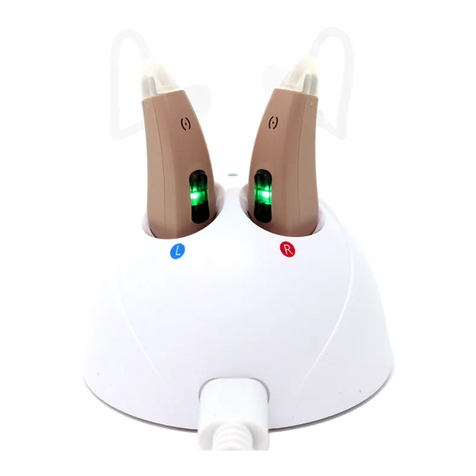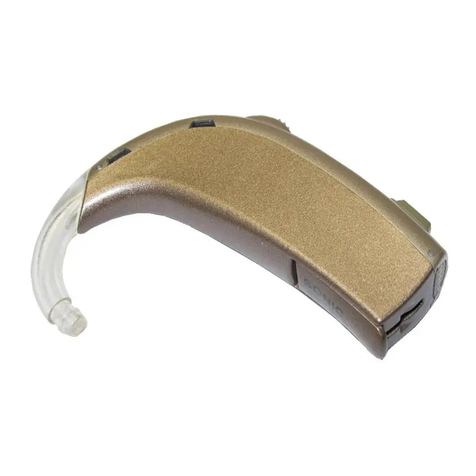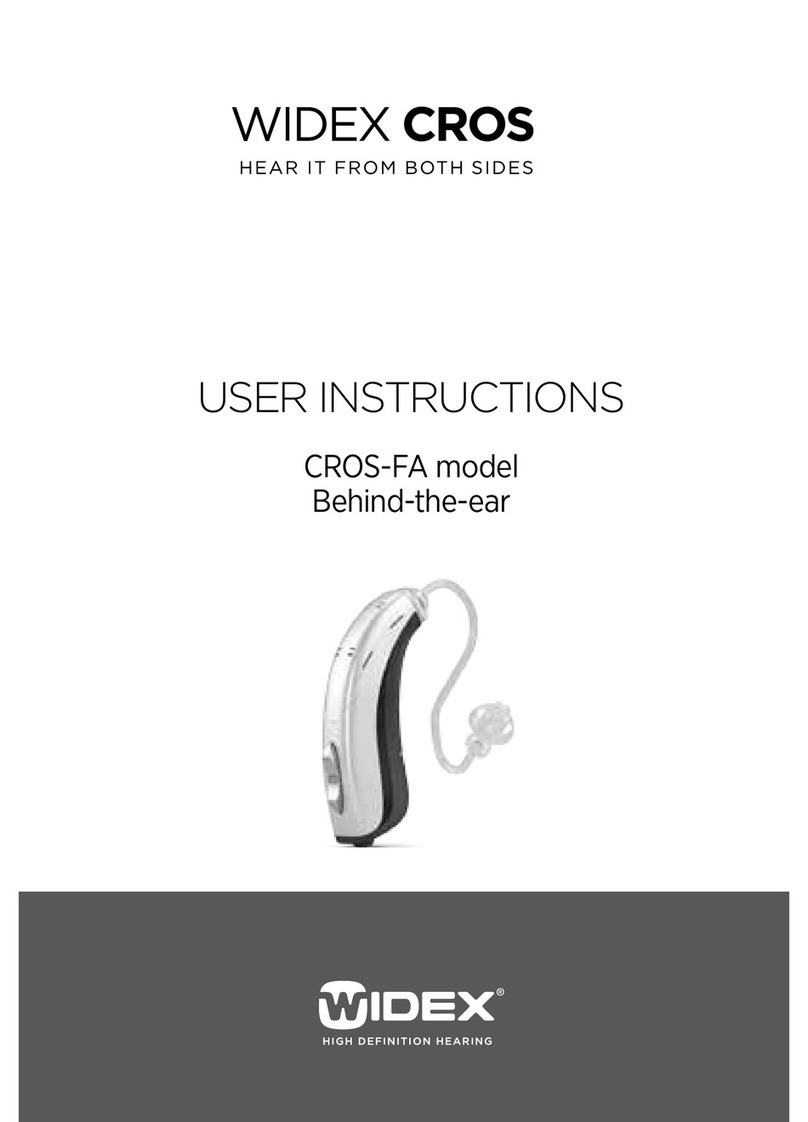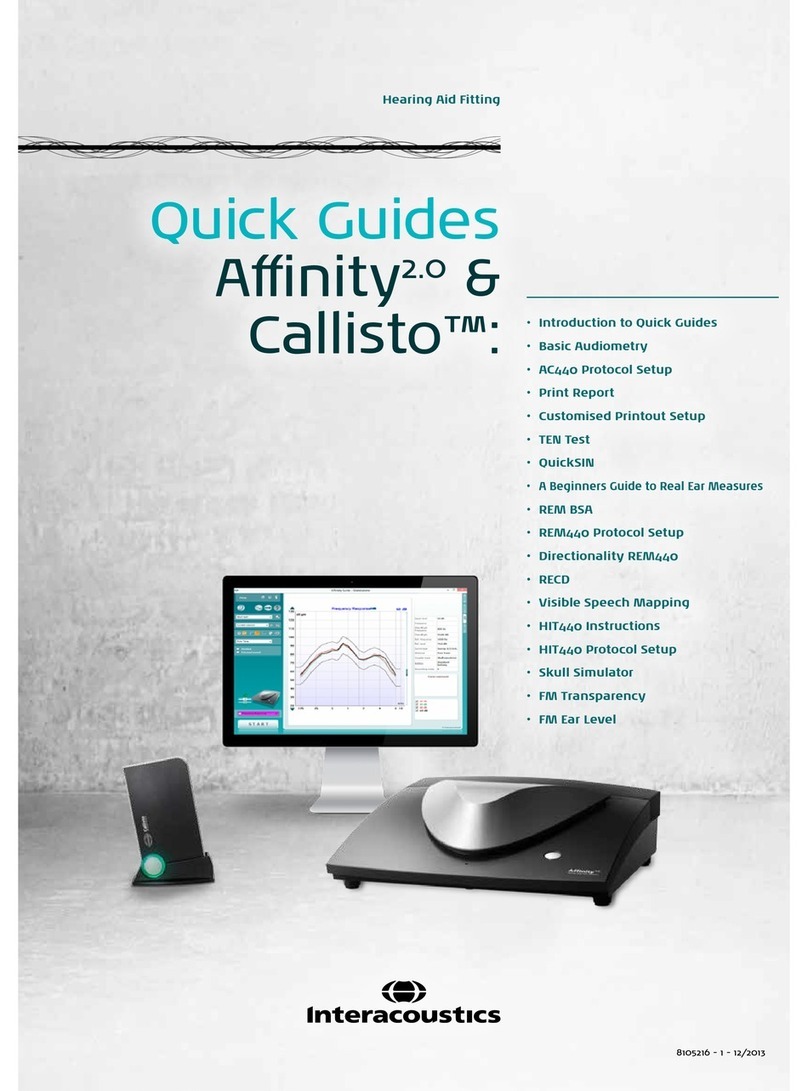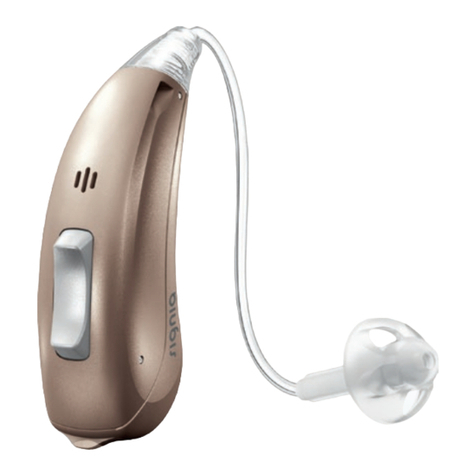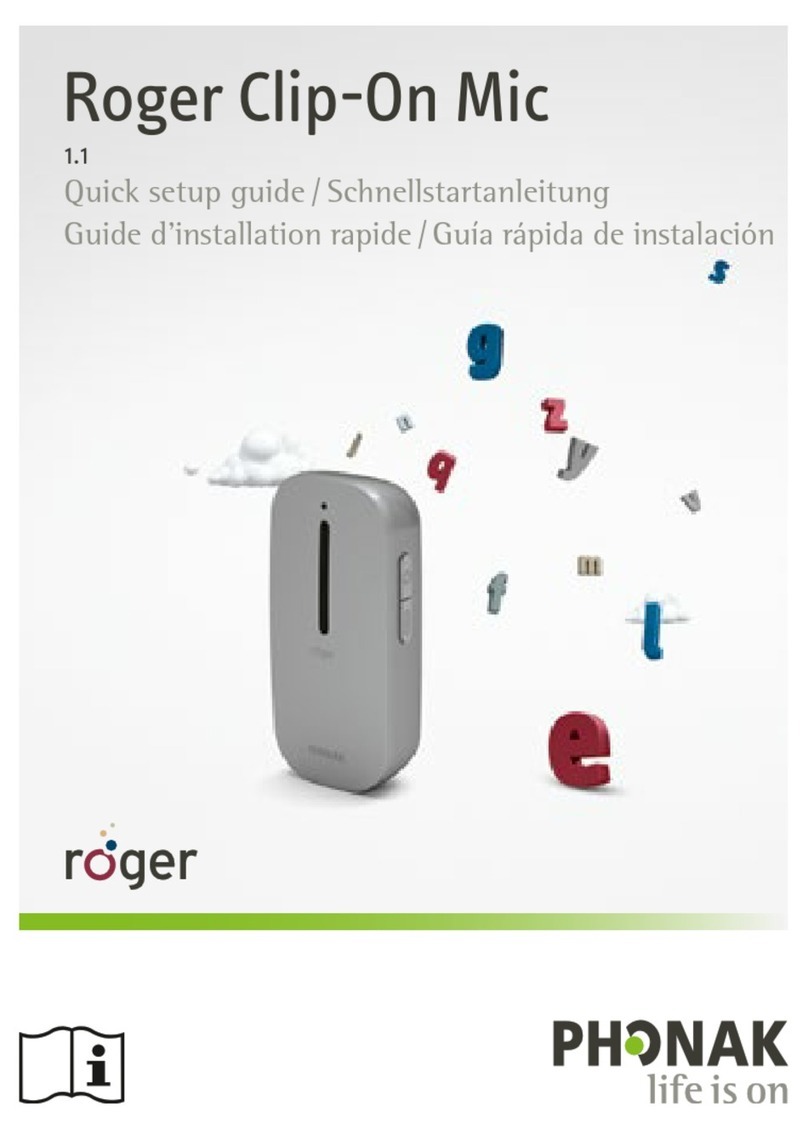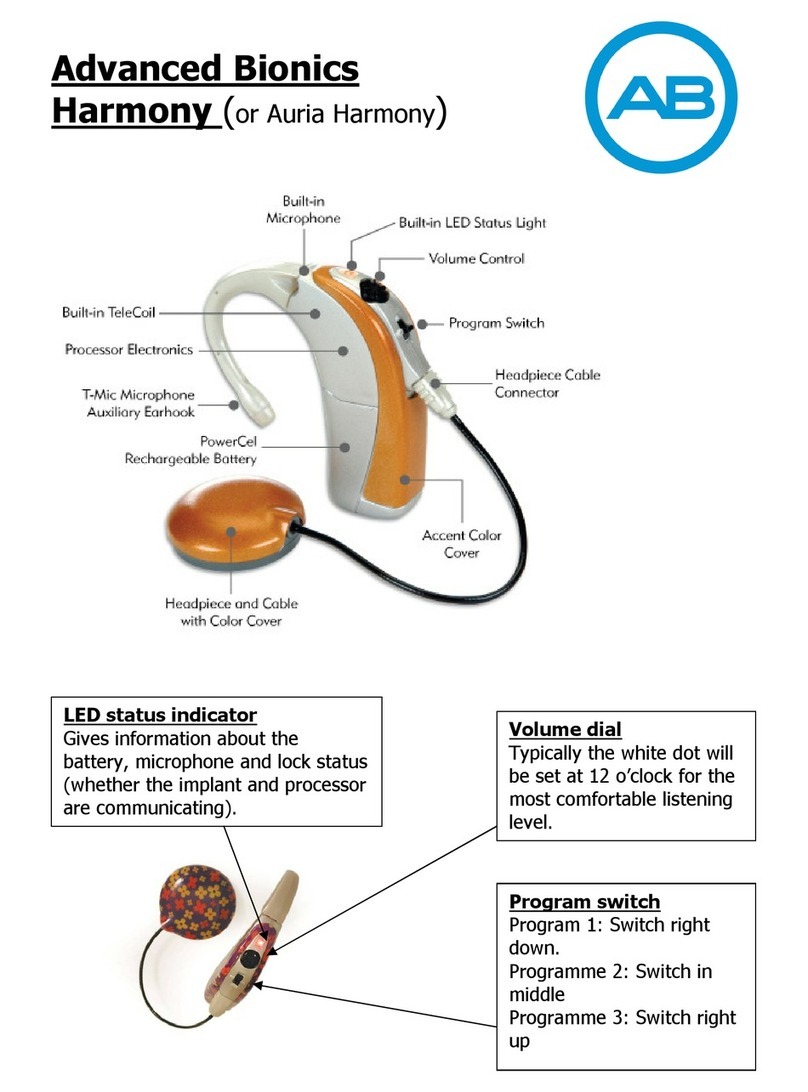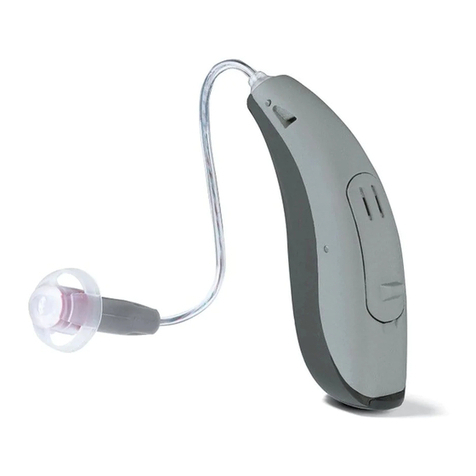Audifon lewi S User manual

lewi S
risa S
Operating instructions
BEHIND THE EARS
HEARING AIDS

CONTENTS
INTRODUCTION ...............................................................
YOUR HEARING AID ..........................................................
. Type ..........................................................................
. Overview....................................................................
. Batteries.....................................................................
. Note on the battery ...........................................
. Low battery warning .........................................
OPERATION ......................................................................
. Construction ..............................................................
. Inserting battery ........................................................
. Removing battery.......................................................
. Switching hearing aids on and o................................
. Inserting and removing hearing aids ...........................
. Inserting with ThinTube.....................................
. Inserting with ear mould ...................................
. Removing hearing aids ......................................
. Volume and program selection ...................................
. Automatic side balancing of hearing aids ...........
. Multifunctional rocker switch............................
. Volume selection ...............................................
. Selecting the hearing programs.........................
TINNITUS COMBI INSTRUMENT........................................
. Startup ......................................................................
WIRELESS FUNCTIONALITY/
BLUETOOTH CONNECTIVITY ............................................
. Using hearing aids with iOS devices ............................
. Pairing hearing aids with the iOS device /
iPhone ..............................................................
. Operating hearing aids with an iOS device /
iPhone ...............................................................
. Operation via the menu MFI Hearing Devices .......
. Operation via the quick start menu....................
Specific function
audifon hearing aids are wearable air conduction hearing aids,
used to compensate for hearing loss of the wearer by recording,
processing and emitting an amplified sound signal. The hear-
ing aids are available with dierent amplifications and output
sound levels, to compensate for light to severe hearing loss.
These hearing aids are not suitable for children under 36 months
of age.
It is additionally possible to activate the tinnitus module inte-
grated in the hearing aid to treat chronic, persistent tinnitus
(a ringing sound in the ears).
The hearing aids are designed for a lifespan of 6 years.
Hearing aids need to be fitted individually by a hearing care
professional or ENT doctor. Diagnostics and the prescription
of hearing aids are the task of an ENT doctor.
Last revised: 01.09.2019

5
INTRODUCTION
Congratulations on the purchase of your new audifon hearing
aids. Your hearing care professional has set this for your
individual requirements. These instructions are therefore
intended to help you use your audifon hearing aids properly.
Please read through the following operating and care
instructions carefully to avoid malfunctions and faults. If
you follow the instructions, your hearing aids will prove an
invaluable help in day-to-day communication with your
surroundings and other people.
The specific model of your hearing aids is shown on the sticker
on the packaging, on the warranty card or printed on the
hearing aids themselves.
Please take note of the following:
Your hearing aid will not make your hearing normal again, nor
will it prevent or improve any physical hearing loss. If you fail to
wear your hearing aid regularly, you will not benefit fully from it.
Use of a hearing aid only accounts for part of your hearing ability
and may need to be supplemented by auditory training and
instruction in lip reading.
If you have any further questions, please contact your hearing
care professional.
. Pairing hearing aids with an Android device ................
. Using hearing aids with the
MULTISTREAMER PRO ...............................................
.. Pairing hearing aids with the
MULTISTREAMER PRO......................................
.. Pairing your smartphone with the
MULTISTREAMER PRO......................................
. Flight mode ................................................................
ACCESSORIES....................................................................
. Compatibility with smartphones ................................
CARE INSTRUCTIONS .......................................................
. General.......................................................................
. Cleaning .....................................................................
. Drying hearing aids.....................................................
DEALING WITH PROBLEMS ...............................................
SAFETY INSTRUCTIONS ....................................................
. Important warnings...................................................
. Notes on product safety.............................................
SIDE EFFECTS ....................................................................
OPERATING CONDITIONS.................................................
TRANSPORT AND STORAGE CONDITIONS .......................
ENVIRONMENTALLY FRIENDLY DISPOSAL.........................
OTHER INFORMATION .....................................................
. EU Declaration of conformity......................................
. FCC Statement ...........................................................
SERVICE ..........................................................................
KEY TO SYMBOLS ..............................................................
WARRANTY CARD

76
. Batteries
To start your hearing aids first insert a battery in the battery
compartment.
Make sure you only use zinc air batteries. Please follow the
instructions on the battery packaging. For the exact type of
battery in your hearing aids please see the overview table.
Always switch your hearing aids o after use. Remove the
battery if your instruments are out of use for long periods, to
avoid damage.
YOUR HEARING AID
. Type
Your hearing aids are behind-the-ear hearing aids.
. Technical features
The detailed acoustic data for your hearing aid can be found
in a separate data specification. This and further information
are available from your hearing care professional or
www.audifon.com.
Model
lewi S
risa S
Minor to severe
hearing loss
Minor to severe
hearing loss
Indication range
Size Average Service
life (zinc air)
in hours Amplification dB
(peak)
Battery

98
.. Note on the battery
A zinc air battery is used to supply the power for your hearing
aids. This type of battery is only activated when oxygen comes
through the air holes into the button cell and the chemical
reaction is started. During production, the air holes are sealed
with a protective strip. This means that the battery remains
fresh until use, and it lasts longer when it is sealed. Removing
the protective strip allows oxygen to enter and the chemical
reaction is activated.
.. Low battery warning
An audible signal indicates the end of the battery life (approx.
30 minutes before the end of the battery’s life).
Important notes:
Refitting the strip when the battery is not
in use will not extend its service life.
Your batteries should be stored at room temperature. Avoid
keeping them in hot places or rooms with high humidity
(e.g. bathroom). Storage in a cooled location is not neces-
sar y.
Never carry batteries loose in a trouser pocket or a purse.
Metal objects like coins or keys could cause batteries to
short-circuit.
Old batteries may contain hazardous substances or heavy
metals that pollute the environment and harm health. Bat-
teries are recycled as they contain valuable raw materials
such as iron, zinc, manganese or nickel. Old batteries should
not be placed in household waste. Consumers are bound
to dispose of batteries at a collection point provided by the
local authority or sales outlet. After use you can also return
the batteries in the appropriate containers at the premises
of your hearing care professional for free.

1110
4
5
3
2
1
OPERATION LEWI S, RISA S
The hearing aids consist of the following elements:
Ear hook
Microphone inlets
Multifunctional rocker switch
Battery compartment / ON/OFF switch
Type label
. Construction
The hearing aids have side markings
in the battery flap:
blue = left, red = right
Your hearing aids may dier from the illustrations.
1
3
5
4
2
. Inserting battery
Remove a battery from its packaging.
If the battery has a protective film, remove
and wait a few minutes before inserting the
battery.
Open the battery compartment carefully
with your fingernail at the opening edge
or press the ON/OFF switch on the battery
compartment until it springs out, swing it
right out.
Please do not open the battery
compartment any wider than shown
here. This might damage the device.
Then insert the battery in the battery
compartment. Make sure the (+) symbol on
the battery matches the (+) symbol on the
battery compartment.
NOTE:Do not force the battery into
the battery compartment. If it does not
fit, check whether you are inserting it
correctly and that it is the correct type of
battery (see Section 2.2).

1312
Open the battery compartment carefully
with your fingernail at the opening edge
or press the ON/OFF switch on the battery
compartment until it springs out, swing it
right out.
Then remove the battery from the battery
compartment.
Please do not open the battery
compartment any wider than shown
in Section 3.2. This might damage
the device.
Your hearing aids are switched on and o via the battery
compartment.
. Removing battery
Switching on
Close the battery compartment securely
with a battery inserted by moving it past the
catch of the OFF position into the casing.
You will feel the battery compartment
clicking into place as you close it.
The hearing aids are now switched on. After
a preset delay and a start-up jingle, the first
program will activate and the hearing aids
are ready for use.
. Switching hearing aids on and o
Switching o
To switch the device o, press the battery
compartment via the ON/OFF switch to the
first catch position.
This is the OFF position.
If the devices will be out of use for a long
time, open the battery compartment fully
and remove the battery.

1514
Switch the hearing aids on by closing the
battery compartment securely.
Place the hearing aid behind your ear.
Slide the earpiece/dome carefully into your
ear canal. Rotate slightly until it is positioned
properly.
Open and close your mouth to avoid air being
trapped in the ear cana
. Inserting and removing hearing aids
Hearing aid
Easy Thin
Tube + Dome
Concha clip
(optional)
The optional concha support helps improve the fit
of the earpiece in the ear. To position the concha
support, bend slightly and place it carefully in the
outer part of your ear.
Caution: Risk of injury!
Always wear the thin sound tube with the
dome and check that the dome is positioned
securely on the tube.
.. Inserting with ear mould
Switch the hearing aids on by closing the
battery compartment securely.
Place the hearing aid behind your ear.
Hearing aid
Otoplastic
Insert the ear mould in your ear, rotating slightly as
you do so.
Move the upper part of the ear mould backwards
and forwards to adjust.
.. Inserting with ThinTube

1716
Warning: Risk of injury!
In very rare cases the dome may remain in the ear
canal on removal. Should this happen, please contact
your doctor or hearing care professional at once.
Please do not try to remove the dome yourself.
Lift your hearing aid and slide carefully over the outer
part of your ear. Carefully pull the tube with the earpiece
out of the ear canal. Switch the hearing aid o by moving
the battery compartment to the OFF position.
.. Removing hearing aids
. Volume and program selection
.. Automatic side balancing of hearing aids
If you have had two hearing aids of the same type adjusted by
your hearing care professional, they are synchronised as a pair.
You can tell this, because after your devices have been switched
on, the pairing melody plays in both hearing aids.
After the hearing aids have been paired, all settings made in
one device are also written to the second device. The tones and
melodies are played in both hearing aids with a slight delay.
If the connection is broken, you do not need to take action. The
devices renew the connection quickly for themselves. You can
tell this, because after your devices have been switched on, the
pairing melody plays in both hearing aids.
Your hearing aids feature a
multifunctional rocker switch for
controlling the volume and selecting
the dierent programs.
The multi-function rocker switch can
be activated by pressing the top (+) and
bottom end (-).
.. Multifunctional rocker switch
Volume control
To control the volume, press the multifunction rocker
switch briefly on the top or bottom button also see ...
Program selector switch
To change the program, press the multifunction rocker
switch briefly on the top or bottom button also see ...
Volume control and program selector switch
combined
To control the volume, press the multifunction rocker
switch briefly on the top or bottom button; to change the
program hold the switch down for approx. second see
also .. and ...

1918
.. Volume selection
The volume can be adjusted in steps
using the multifunction rocker switch.
Briefly pressing the top end of the switch
increases the volume, while briefly
pressing the bottom end reduces the
volume.
When you switch your devices on, they will
be at the volume set for you. You can only
increase or reduce the volume in steps.
Each time you press the switch, you will
hear audible confirmation.
Once you have reached the upper or lower
volume limit, you will hear a clear signal.
Volume control and program selection
are optional functions. Your hearing
care professional will set your hearing
aids to your individual requirements.
.. Selecting the hearing programs
Multifunctional rocker switch
Your hearing care professional will have adjusted your hearing
aids to various hearing situations with you and assigned them
to specific hearing programs. The multifunction rocker switch
allows you to swap between the hearing programs.
To do so, simply hold down one end of the multifunction rocker
switch until you hear audible confirmation of the change in
program with a tone. After you have released the multifunction
rocker switch, the melody for the selected program is played.
The number of signals indicates the number of the program
selected. You can move through the hearing situations up or
down. Your hearing care professional has set the number of
selectable programs for your individual requirements.
+ key:
key:
Program change sequence*:
* Example with 3 hearing programs
Volume control and program selection are optional
functions. Your hearing care professional will set your
hearing aids to your individual requirements

2120
Hearing program
Description of setting TINNITUS COMBI INSTRUMENT
Combi hearing aids from audifon play an eective part in
tinnitus therapy.
These instruments are designed to accustom you to your
tinnitus and/or hyperacusis and will help correct disorders of
the audiological system, compensate for tinnitus and improve
existing hyperacusis.
Your hearing care professional will have adjusted the combi
hearing aids to your individual hearing situation with you.
. Startup
Information on operating devices with active tinnitus modules
can be found in Section 3 of these operating instructions.
Warning: Damage to hearing!
The maximum volume of the tinnitus combi instrument lies
in a range that can lead to hearing loss according to OSHA
regulations. The tinnitus combi instrument should not be
used for longer than eight (8) hours, at a sound pressure
level (SPL) of less than 90 dB SPL. At a higher sound pressure,
the device should not be used for more than two (2) hours
daily. Under no circumstances should the tinnitus combi
instrument be used with a volume that is not appropriate
for the user.

2322
WIRELESS FUNCTIONALITY /
BLUETOOTH CONNECTIVITY
. Using hearing aids with iOS devices
.. Pairing hearing aids with the iOS device / iPhone
To be able to use your hearing aids via your iOS device, you have
to pair it with your iOS device. This is how the hearing aids and
the iOS device communicate with each other. Please follow the
instructions to successfully pair the hearing aids.
1. Press the settings icon on your iOS device.
2. In the Settings menu go to: General → Accessibility →
MFi Hearing Devices under the hearing category
3. If the Bluetooth function is still deactivated on this screen,
activate Bluetooth. While the iOS device is looking for hearing
aids, open and close the battery compartments of your
hearing aids (this puts the hearing aids into pairing mode)
4. Among the devices now displayed, the device name of your
hearing aids appears, created based on your first names. If
this does not happen within 5–7 seconds, press the upper left
edge of the screen to go back to <Accessibility and open MFI
Hearing Devices again.
5. After your hearing aids are displayed, select these from the
list, to connect the devices with the iOS device.
.. Operating hearing aids with an iOS device / iPhone
Your made-for-iPhone hearing aid is equipped for operation with
an iPhone, iPad or iPod Touch.
To use your hearing aid with an iOS device, pair the hearing aid
as described in Section 5.1.1.
There are two ways for you to operate your hearing aids with
your iOS device:
1. Via the menu MFI Hearing Devices
2. Via the quick start menu of the iOS device
In both menus you have access to set
1. The microphone volume
2. The desired hearing program
3. The listening function via your iOS device, with which
the audio signals from the microphone of the iOS device are
transmitted directly to your hearing aids.
6. Two pairing requests appear – one for each hearing aid.
Select Pair to make a final connection. Both requests can be
delayed by a couple of seconds.
7. Pairing is now complete.

2524
5.1.3 Operation via the menu MFI Hearing Devices
Navigate to the sub-menu MFi Hearing Devices.
You can find this under
Settings
→ General
→ Accessibility
→ MFi Hearing Devices
Your connected hearing aids are displayed here. Select the
connected hearing aids via Connected, to reach the hearing aid
settings.
5.1.4 Operation via the quick start menu
Press the home button three times. The MFi Hearing Devices
menu opens.
If you require support for pairing or using the devices
listed above with your hearing aid, please contact your
hearing care professional.
For further operating functions, let your hearing care
professional explain to you about the related free app.
5.2 Pairing hearing aids with an Android device
To be able to use your hearing aids via your Android device, you
have to pair it with your Android device. This is how the hearing
aids and the Android device communicate with each other.
Please follow the instructions to successfully pair the hearing
aids.
1. Press the settings icon.
2. Select Bluetooth.
3. Change the settings in On, if Bluetooth is switched o. Open
and close the battery compartment of the hearing systems.
This lets you transfer the hearing systems into pairing mode.
4. Under Paired devices you can see your first name, followed
by Hearing Aid, if the hearing systems were detected. If the
name does not appear on the list of paired devices within
5–7 seconds, press the Accessibility Icon in the top left corner,
then on hearing aids.
5. The right hearing system appears on the list once, as does
the left hearing system. Both list entries must be clicked for
pairing.
6. Pairing is complete.

2726
To use your hearing aids with an Android device, a TV or
other devices that have an AUX output, you can get the
MULTISTREAMER PRO accessory from your hearing care
professional.
When you purchased your MULTISTREAMER PRO from your
hearing care professional, you connected your hearing aids to
the MULTISTREAMER PRO for the first time with them. This
means that the initialisation of the connection is completed.
From now on you can connect your hearing aids automatically
to your MULTISTREAMER PRO. To do this, just switch on your
MULTISTREAMER PRO and then (within 180 seconds) your
hearing aid(s).
Switch on the MULTISTREAMER PRO. Then press the multi-
function button for 5 seconds. The LED changes to red then
flashing blue. Refresh the Bluetooth menu in your smartphone.
The MULTISTREAMER PRO is displayed in the selection. Select
the device, and select Pair. The MULTISTREAMER PRO is paired
with your smartphone..
For further operating functions see the operating
instructions of the MULTISTREAMER PRO, included with
your MULTISTREAMER PRO.
5.4 Flight mode
When you enter an aeroplane or areas where transmission of
wireless signals is forbidden, you must switch o the wireless
functions of your electronic devices.
For this reason, please put your
hearing aids in flight mode in these
situations, or if in doubt speak to
trained personnel.
To switch your hearing aid to
flight mode, please press the
multifunctional rocker switch up for
5 seconds. All wireless functions of
your hearing aids are now switched
o.
If you switch the hearing aids o
and on again, all functions are
reactivated.
5.3 Using hearing aids with the MULTISTREAMER PRO
5.3.2 Pairing your smartphone with the
MULTISTREAMER PRO
5.3.1 Pairing hearing aids with the MULTISTREAMER PRO

2928
ACCESSORIES
The hearing aids of the lewi and risa families have the following
accessories, which you can obtain from your hearing care
professional. You can download the audifon app for free in the
corresponding platforms. For more information, please contact
your hearing care professional.
6.1 Compatibility with smart-phones
The hearing aids of the families lewi and risa are compatible
with common smart-phones, which have Bluetooth version 4.0
or higher, if necessary, the accessory product multistreamerpro
be necessary for an audio transmission (eg Android operating
system of the smart-phone).
For a list of the lewi and risa family of hearing aids and audifon
app compatible smart-phones, tablets, etc., visit:
www.audifon.com
Accessories
audifon app
mutistreamer pro
UniTip Soundshell
UniTip Domes
UniTip ThinTubes
Concha Clip
CeruStop Filter
Side marking
audifit Software
from Version .
smartphone App for remote control of your hearing aids
audio streamer to enhance the functionality of your hear
ing aids
Individual earmold for your hearing aids
Universal ear pieces for use with your hearing aid
Thin tubes to fit the hearing aids with mild to moderate
hearing losses
Concha clip fixes the UniTip receiver unit in the ear canal
Small filter that protects the earphone from blockage and
should be replaced regularly
Red and blue markers that can help to easily associate the
hearing aids with one ear
Fitting software that the hearing aid specialist uses to fit the
hearing aids for you
Description

. Cleaning
The ear adapter pieces and the flexible
plastic tubing attached to them must
be detached from the ear hook before
cleaning. Only use recommended products
for cleaning the ear adapter pieces.
In the case of hearing aids with a thin
sound tube, the screwed connection
between the tube and hearing aid can
be detached. The dome is removed for
cleaning.
Ear adapter piece
Thin Tube
CARE INSTRUCTIONS
7.1 General
audifon hearing aids will improve your hearing ability as well
as your quality of life. To ensure your hearing aids function
perfectly and so make hearing a pleasant experience for years
to come, audifon oers special care products designed to enable
optimum cleaning of your devices.
Protect your hearing aids against moisture (e.g. showers, sweat,
rain), and take your hearing aids out before using hairspray or
similar cosmetic products.
We also recommend that you carry out daily care on your
hearing aids, as the devices are exposed to moisture and dust
through intended use, even if they are handled with care.
Whatever type of hearing aid you use: Every one is in direct
contact with the skin. This produces perspiration, which may
damage your hearing aid in the long term unless dried on a daily
basis. audifon’s behind-the-ear hearing aids are coated with a
water-repellent finish, known as the nanoShield, to prevent any
damage from moisture.
Wearing a hearing aid or insertion of the ear adapter piece in the
ear canal will always involve soiling with earwax. For this reason
we recommend regular cleaning. Do not use a damp cloth to
clean your hearing aids. Always use a soft, dry cloth.
Should your hearing aid still not function correctly despite
regular care, call on your hearing care professional. Do not try
under any circumstances to repair your hearing aid yourself.
3130

dry go
The audifon dry go is the perfect solution for drying your devices
when on trips or out and about. Once connected, for example to
the USB port on your laptop, the drying program can be conve-
niently started at the touch of a single button. A flow of warm
air inside the audifon dry go will then dry your devices reliably.
The drying station switches o
automatically at the end
of the drying program.
dry star UV
The audifon dry star UV 2 will dry your tinnitus instruments
gently yet thoroughly thanks to the constant circulation of uni-
formly warm air inside the casing. At the same time, the UVC
radiation used here will kill 99.9% of all common bacteria.
The audifon dry star UV 2 is not only automatic but al-
so consumes very little power, switching itself o at
the end of the drying program. The drying station is
simple to operate using a single sensor button.
. Drying hearing aids
Your hearing aids should be dried after use at the end of the day
and above all after cleaning. If you take care of your hearing aids
by drying them carefully, this will significantly increase their
service life. There are two ways of doing this. If you have an
audifon drying station of the type dry star UV 2 or dry go, use
this for drying. Take note of the individual product instructions
for further details. Alternatively, you can dry your hearing aids
in the audifon pro care Drying-Tub with an audifon Drying-
Capsule.
3332

DEALING WITH PROBLEMS
If you experience any malfunctions when using your hear-
ing aids, this does not necessarily mean that they are faulty.
Therefore first check your hearing aid to make sure that:
•the hearing aid is switched on (see “Switching on and o”
Section 3.4),
•the battery is not weak or flat,
•the volume is not at the lowest setting (increase the volume
slightly if necessary),
•the right program has been set (change program if
necessary),
•the receiver unit / earwax protection system is not blocked.
If this does not eliminate the fault, consult your hearing care
professional, who will be pleased to help you.
NOTE: MALFUNCTIONS!
Despite their EMC-compatible design, your devices may
be subject to interference from other electrical equipment.
In this case move away from the source of interference.
Warning: Risk of suocation!
Batteries, hearing aids and other small parts can be swal-
lowed. Keep such parts out of the reach of children under
36 month years of age, the mentally disabled and pets.
Should a battery, hearing aid or other small parts be acci-
dentally swallowed, please consult a doctor immediately.
Warning: Risk of injury!
In very rare cases the dome may remain in the ear
canal on removal. Should this happen, please contact
your doctor or hearing care professional at once.
Please do not try to remove the dome yourself.
Warning: Damage to hearing!
The maximum volume of the tinnitus combi instrument lies in
a range that can lead to hearing loss according to OSHA regu-
lations. The tinnitus combi instrument should not be used for
longer than eight (8) hours, at a sound pressure level (SPL) of
less than 90 dB SPL. At a higher sound pressure, the device
should not be used for more than two (2) hours daily. Under no
circumstances should the tinnitus combi instrument be used
with a volume that is not appropriate for the user.
Warning: Risk of explosion!
Do not use hearing aids in environments where there
is a risk of explosion (e.g. in mines or industrial plants
subject to such risk).
SAFETY INSTRUCTIONS
. Important warnings
3534

Warning: Risk of injury!
Hearing aids are adjusted to the individual hearing loss
of each wearer and should therefore only be used by this
person.
If the hearing aid is worn by other persons, this may harm
their hearing.
Warning: Risk of injury!
Please only use genuine consumables specified by the man-
ufacturer (dome, tubing, etc.) and accessories. Unauthor-
ised changes or modifications that have not been explicitly
approved may in the worst-case scenario result in injury.
Warning: Interference with active and inactive
implants!
If you have an active or inactive implant (e.g. defibrillator,
pacemaker), follow the implant manufacturer’s instructions
regarding use of mobile devices. In case of malfunctions,
stop using your hearing aid and contact your doctor or the
implant manufacturer.
If you have an active brain implant, ask your doctor or the
implant manufacturer for a risk analysis.
Caution: Risk of injury!
Always wear the tube with the earpiece and check that the
earpiece is positioned securely on the tube.
Warning: Radio communications in rooms
Before making a connection between radio communica-
tions and the hearing aids, you should check whether use of
radio communications is restricted in the room/area.
Note: Damage to hearing aid!
Hearing aids are susceptible to impact, So avoid any hard
knocks (e.g. by dropping them).
Note: Changes to the device
No changes may be made to the hearing aids unless they are
made directly by the manufacturer.
Note:
To avoid damage to your hearing aids, do not wear them in
the following situations:
•when swimming, in the shower or bath
•when washing your hair or using a hairdryer
•when using hair spray, perfume, aftershave or body lotion
• during high-frequency heat therapy treatment
• when it is very hot or raining heavily
Should your hearing aid become damp, remove the battery
and dry the hearing aid in one of the drying containers speci-
fied by the manufacturer. Do not dry your hearing aid in the
microwave under any circumstances.
Note: Damage to hearing aid!
Do not force the battery into the battery compartment. If it
does not fit, check whether you are inserting it correctly and
that it is the correct type of battery.
. Notes on product safety
3736

Note: Leaking batteries can damage your hearing aid!
If you are not going to use your hearing aids for a significant
length of time, remove the battery to increase its life
expectancy, to avoid leakage and to prevent corrosion on
the battery contacts.
Note: Strong radiation can damage hearing aids!
Make sure you take out your hearing aids if you are under-
going a CT or MRI scan, other magnetic field-based exami-
nations or radiotherapy.
Note: Damage to hearing aid!
Never leave your hearing aid in the sun, near a naked
flame or in a hot vehicle. Otherwise your hearing aids
might become damaged.
Note: Damage to hearing aid!
Never try to change the shape of your hearing aid, ear
mould or tubing yourself. Otherwise your hearing aids
might become damaged.
Note: Malfunctions!
Despite their EMC-compatible design, your devices may be
subject to interference from other electrical equipment.
In this case move away from the source of interference.
Note: Interference with electronic devices!
If you are in an environment where use of electronic or
wireless devices is restricted, check if your hearing aids
must be turned o.
Note: User age!
The hearing aids are not intended for children under
36 months.
Reporting serious incidents!
All serious incidents related to the product that occur
should be reported to the manufacturer and to the respon-
sible authorities in the member state in which the user and/
or the patient are registered.
3938
Other manuals for lewi S
2
This manual suits for next models
3
Table of contents
Other Audifon Hearing Aid manuals
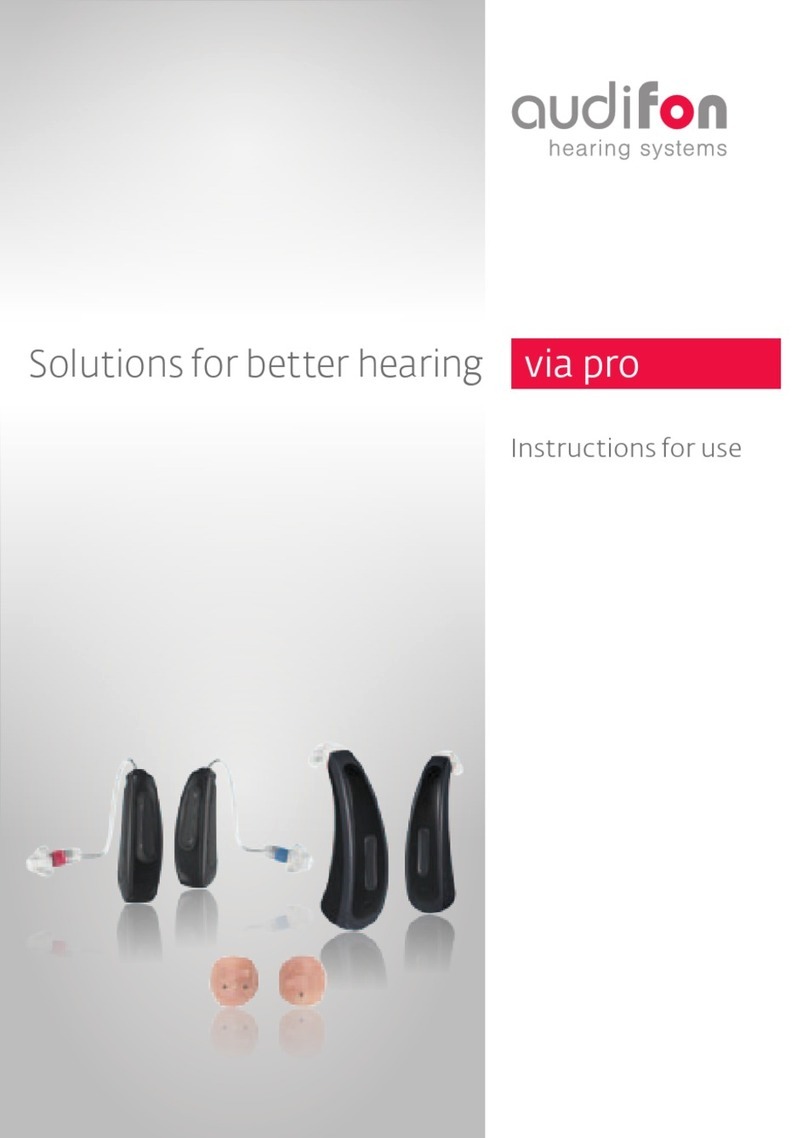
Audifon
Audifon via pro User manual

Audifon
Audifon sueno pro S User manual

Audifon
Audifon lewi S User manual
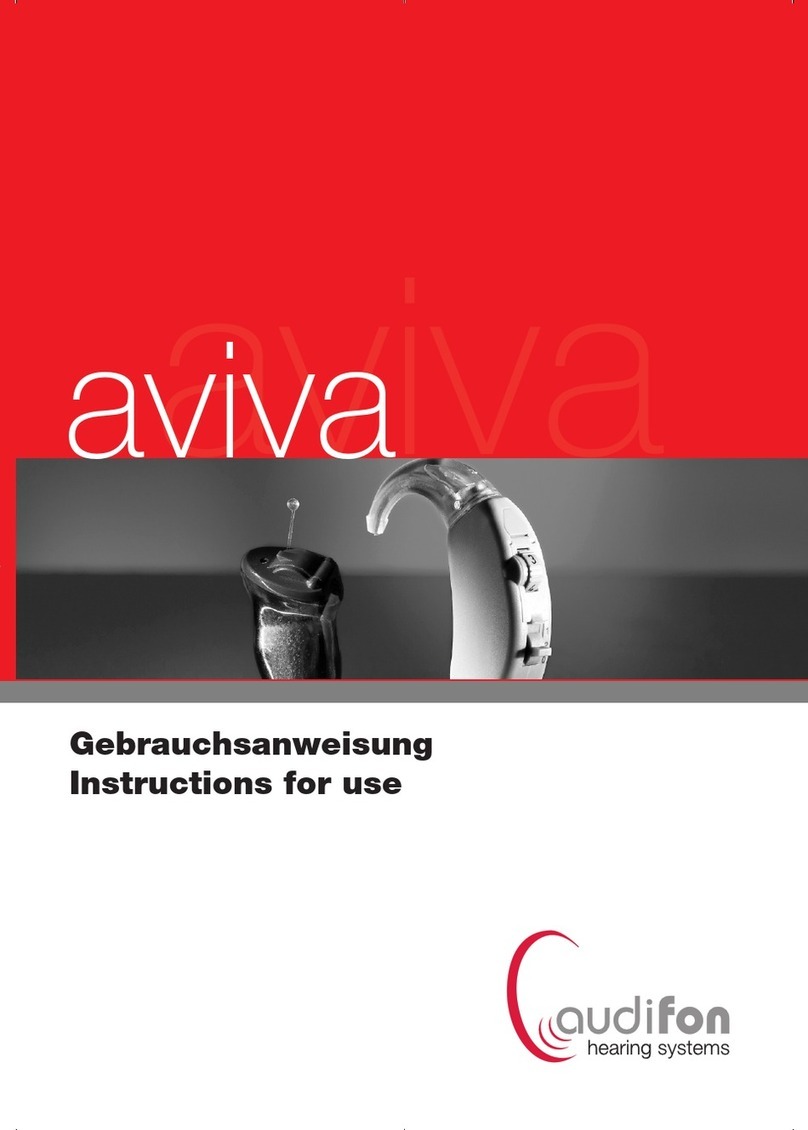
Audifon
Audifon aviva Series User manual
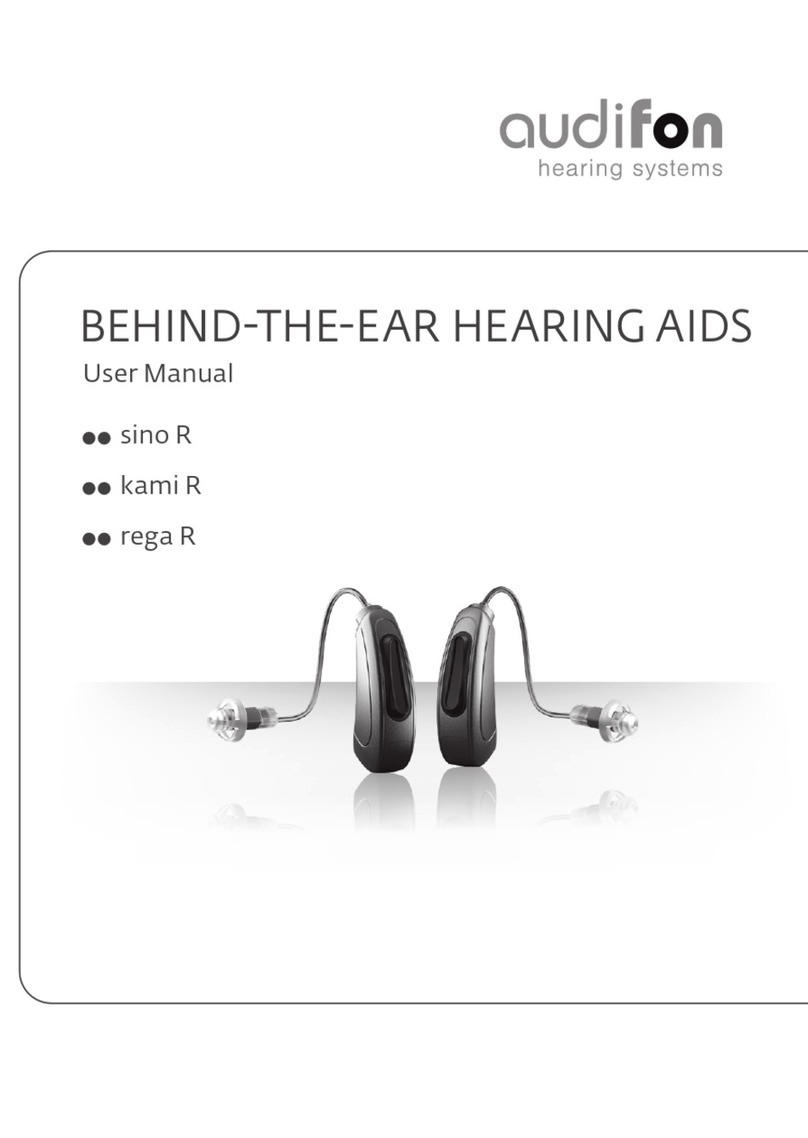
Audifon
Audifon sino R User manual

Audifon
Audifon sino S User manual
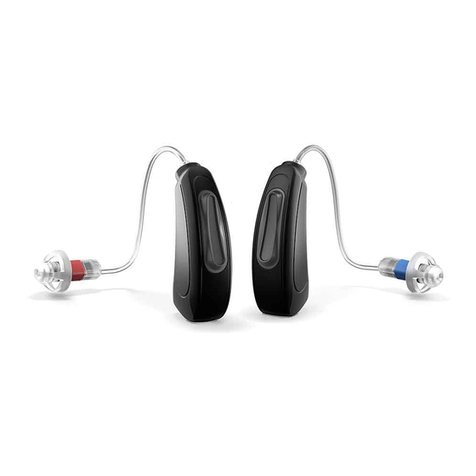
Audifon
Audifon lewi R User manual

Audifon
Audifon eox M User manual
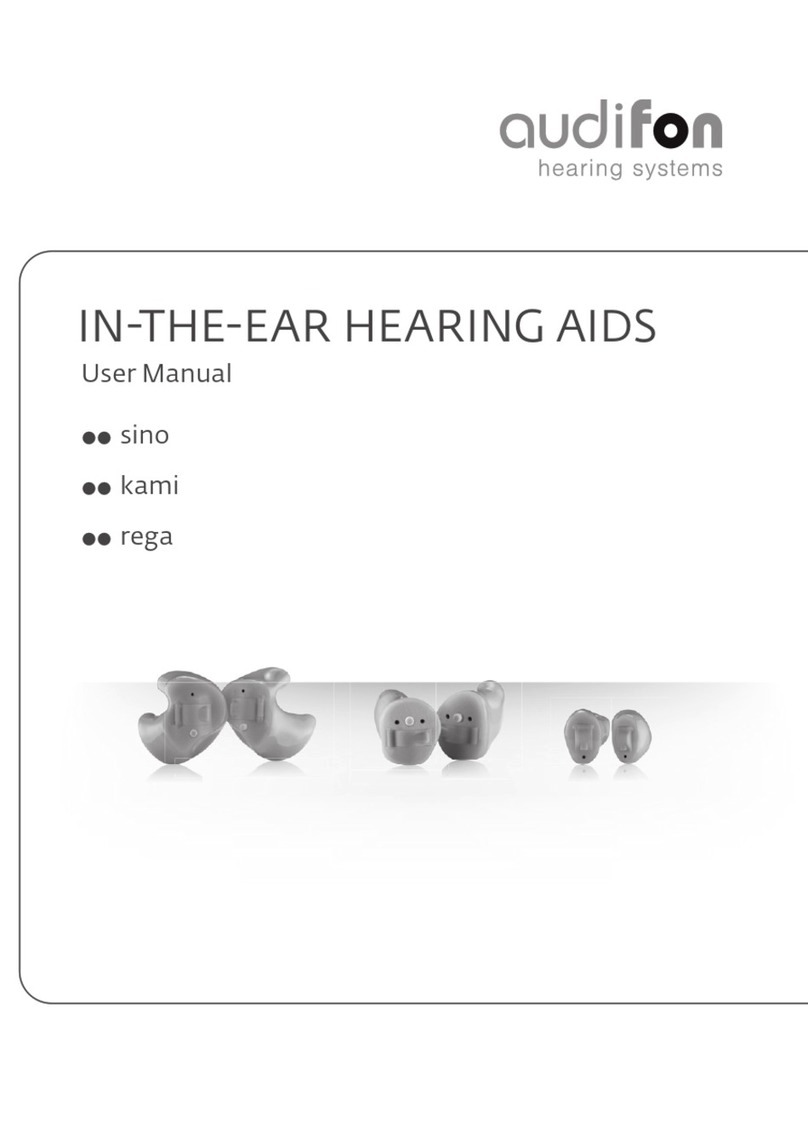
Audifon
Audifon rega pico User manual
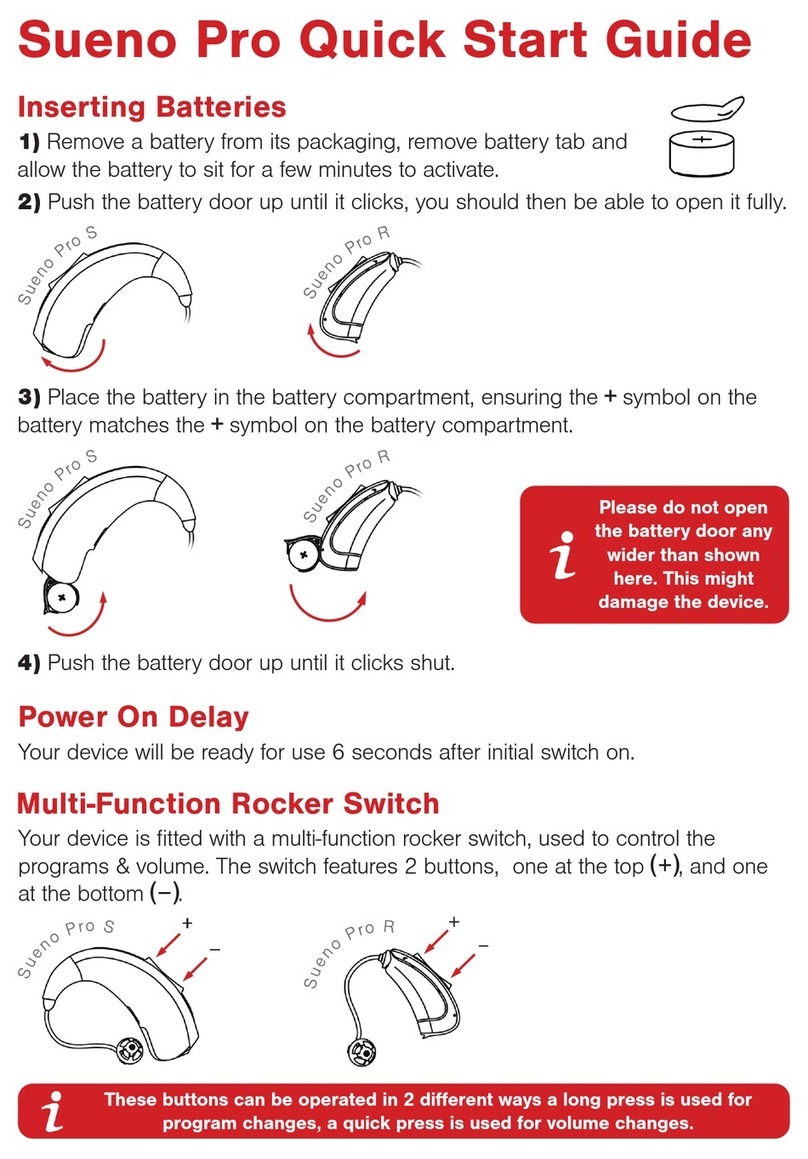
Audifon
Audifon Sueno Pro User manual





